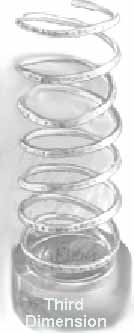June 12, 2006
Weeks ago, the expression The Theory of Everything repeated in my mind over and over again. I had to laugh when I read that the 'Theory of Everything' is called TOE, as I stubbed the pinky toe on my right foot the day I first heard the expression.
A theory of everything (TOE) is a hypothetical theory of theoretical physics that fully explains and links together all known physical phenomena. Initially, the term was used with an ironic connotation to refer to various overgeneralized theories. For example, a great-grandfather of Iion Tichy, a character from a cycle of Stanislaw Lem's science fiction stories of 1960s, was known to work on the "General Theory of Everything". Over time, the term stuck in popularizations of quantum physics to describe a theory that would unify or explain through a single model the theories of all fundamental interactions of nature.
There have been numerous theories of everything proposed by theoretical physicists over the last century, but as yet none have been able to stand up to experimental scrutiny as there is tremendous difficulty in getting the theories to produce experimentally testable results. The primary problem in producing a TOE is that the accepted theories of quantum mechanics and general relativity propose radically different descriptions of the universe, and straightforward ways of combining the two lead quickly to the renormalization problem in which the theory does not give finite results for experimentally testable quantities. Lastly, a number of physicists do not expect a TOE to be discovered.
Albert Einstein was the first well-known scientist who spent most of his life trying to find a TOE; he believed that the only task was to unify general relativity and electromagnetism.
Current mainstream physics concepts require a TOE to unify all the fundamental interactions of nature, which are usually considered to be four in number: gravity, the strong nuclear force, the weak nuclear force, and the electromagnetic force; it should also explain the spectrum of elementary particles. There has been progress toward a TOE in unifying electromagnetism and the weak nuclear force in an electroweak unified field theory and in unifying all of the forces except for gravity (which in the present theory of general relativity is not a force) in the grand unification theory. One missing piece in a theory of everything involves combining quantum mechanics and general relativity into a theory of quantum gravity.
The only mainstream candidate for a theory of everything at the moment is superstring theory / M-theory; current research on loop quantum gravity may eventually play a fundamental role in a TOE, but that is not its primary aim. These theories attempt to deal with the renormalization problem by setting up some lower bound on the length scales possible. Also, early 21st century theories of everything tend to suppose that the universe actually has more dimensions than the easily observed three of space and one of time.
The motivation behind this approach began with the Kaluza-Klein theory in which it was noted that applying general relativity to a five dimensional universe (with the usual four dimensions plus one small curled-up dimension) yields the equivalent of the usual general relativity in four dimensions together with Maxwell's equations (electromagnetism, also in four dimensions). This has led to efforts to work with theories with large number of dimensions in the hopes that this would produce equations which are similar to known laws of physics.
The notion of extra dimensions also helps to resolve the hierarchy problem which is the question of why gravity is so much weaker than any other force. The common answer involves gravity leaking into the extra dimensions in ways that the other forces do not.
One major criticism to the addition of numerous extra dimensions in the mathematically complex String Theory is that the parameters of this theory can be bent far enough to encompass almost any observation predictable by other current theories, and thus cannot make useful (as in original, falsifiable, and verifiable with current technology) predictions. In this view, String Theory would be considered a pseudoscience, where an unfalsifiable theory is constantly adapted to fit the experimental results.
In the late 1990s, it was noted that one problem with several of the candidates for theories of everything was that they did not constrain the characteristics of the predicted universe. For example, many theories of quantum gravity can create universes with arbitrary numbers of dimensions or with arbitrary cosmological constants. One bit of speculation is that there may indeed be a huge number of universes, but that only a small number of them are habitable, and hence the fundamental constants of the universe are ultimately the result of the anthropic principle rather than a consequence of the theory of everything. Max Tegmark has taken this principle to its logical conclusion with his "Ultimate ensemble", whose only postulate is that "all structures that exist mathematically exist also physically". In this theory, certain mathematical structures are complex enough to contain self aware substructures, who subjectively perceive themselves as existing in a physically real world.
There is also a philosophical debate within the physics community as to whether or not a "theory of everything" should be seen as the fundamental law of the universe. One view is the hard reductionist view that the TOE is the fundamental law of the universe and that all other theories of the universe are a consequence of the TOE. Another view is that there are laws which Steven Weinberg calls free floating laws which govern the behavior of complex systems, and while these laws are related to the theory of everything, they cannot be seen as less fundamental than the TOE. Some argue that this explanation would violate Occam's Razor if a completely valid TOE were formulated.
Other possibilities which may frustrate the explanatory capacity of a TOE may include sensitivity to the boundary conditions of the universe, or the existence of mathematical chaos in its solutions, making its predictions precise, but useless.
There have been several attempts to advance the general theory of relativity as a theory of everything. As mentioned above, Einstein was responsible for one of these: in collaboration with Rosen he attempted to model particles as tiny wormholes, hence the term Einstein-Rosen Bridge. Wormholes have also been proposed at various times to explain Bell violations not as superluminal influences but influences that take a shortcut through a wormhole. Such theories face a number of hurdles: the creation of wormholes changes the topology of spacetime by creating a new "handle" which implies violations of causality, and the general theory of relativity predicts its own breakdown at a Gravitational singularity by theorems of Stephen Hawking and Roger Penrose.
A recent effort to surmount this hurdle notes that the equivalence principle can be applied along curves rather than at a single point, which would imply that time dilation of 1/2 is indistinguishable locally (along the curve) from a relative velocity v and the unbounded time dilation observed as an event horizon emerges at the center of a collapsing star implies that the center is in reality as well as appearance receding at a velocity approaching the speed of light, producing a bubble-like local inflation of the star's interior. This approach skirts the trapped surface assumption of the singularity theorems of Hawking and Penrose. It posits that quantum behavior is an emergent phenomenon in general relativity caused by a stochastic gravitational background radiation, in which colliding gravitational waves create virtual particle pairs in the form of wormholes as a type of continuous spatial automaton, and the interference pattern in the two-slit experiment is caused by interference between gravitational wavefronts.
The status of a physical TOE is open to philosophical debate. For instance, if physicalism is true, a physical TOE would coincide with a philosophical theory of everything. Some philosophers , Aristotle, Plato, Hegel, Whitehead, have attempted to construct all-encompassing systems. Others are highly dubious about the very possibility of such an exercise.
Many theists believe the universe should operate according to consistent principles because they believe it to have been designed by a rational and orderly deity. Some theists believe no TOE will be found, while some others speculate that a TOE would provide a new concept of this deity as a universal teleological principle, a natural phenomenon, rather than supernatural. Yet other theists believe that the discovery of a TOE would not change anything in regards to their belief. Others expect that a TOE, like modern physics, would be agnostic as it would by definition describe only the universe, this is assuming, however, that deities would be separate from the universe.

It's all connected through ...
Games in the Grid, In the Box
Zero Point Theory and 'X', As is Above, So is Below

Games ... The spiraling loops of time
The soul/sole, the TOE, past, present, and future
Where do you fit into TOE in any or all lifetimes?
I never play computer games so I have idea what goes on there, but here is a summation of readers' emails and views on video games and metaphysics.
From Judy in Tulsa
Through the past 5 years or so that I have been following your website, I have had many "Aha" moments, but lately I have had a few that just have made me giggle. Today however, the giggle turned into an all out belly laugh as I read your pinky toe, TOE column.
I have to tell you about MY recent pinky toe experience, since it so funny and so very ......... well you will see. A couple of weeks ago I was running through my apartment. As I ran, I stubbed my pinkytoe and heard a loud CRACK! Eekk did that hurt! As I limped to the couch and rubbed my foot, I realized I had most likely broken it.
Soon afterwards, my husband decided he wanted to watch a favorite old comedy, "Harlem Nights". Since my foot was in pain at the time, I watched it with him, though lately television, with the exception of SG1 and Battlestar Gallactica, does not interest me. As the movie progressed I found myself laughing at one particular scene where a very outspoken female character gets her pinky toe shot off by accident. I laughed particularly hard given my own pinky toe incident.
From that day on the word 'pinky toe' floated in my mind so much so that when I logged onto a virtual game world, called World of Warcraft and named my new character, Pinkytoe. I am 51 years old and play an online computer game for relaxation and entertainment.
When I logged onto Ellie's World on Monday, I chuckled at first then had a great belly laugh at this quote:
How funny is that!? To make matters even more delightful, there is a group of players who called themselves 'Occam's Razor' running about in our little virtual world. I am attaching a screen shot of little Pinkytoe.
Thanks again for the lessons and giggles.
Hugs, Judy

Reality is a virtual game through which we experience and interact.